Rooibos Tasting Notes
There is a distinct honey whiff over subtle herbaceous notes; a distant hint of wood. The contents of teacup are dark and brooding, a deep rusted red, like metal that’s been stripped down by the corrosive touch of sea air.
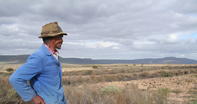
It is dark enough to obscure the bottom of the cup. This is the aroma, flavour and colour of the Suid Bokkeveld’s best wild tea, steaming within the rim of a teacup during an informal comparative tea tasting in a suburban Cape Town kitchen.
Alongside a cup of commercial rooibos tea – with its knock-you-down herby, organic smells and paler, orange-brown colour – the characteristics which set the wild rooibos brew apart might be indistinguishable to an untrained palate.
But to the fathers of commercial rooibos tea farming, it was enough to relegate this wild tea from Nieuwoudtville to the cups of peasants and poor folk who for generations had picked over the flanks of the Cederberg Mountains for the distinctive needle-like leaves and branches.
Nowhere Else on the Planet
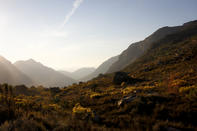
Rooibos grows wild in mountain fynbos vegetation type on the Cederberg Mountains and surrounds in the Western and Northern Cape. That’s it. Nowhere else on the planet. The Khoisan first used it, and their knowledge of the plant has been passed down the generations so that many rural communities today still know the wild plants and collect it for their own use.
There are at least four types of wild rooibos which the locals collected – and it was from this indigenous knowledge that the first foray into commercial rooibos began, with some export of the product to Europe at the beginning of the 1900s.
But it was local medical doctor Le Fras Nortier, and the poet and botanist C Louis Leipoldt, who are credited with carving a fork in the road which allowed one type of rooibos, today known as Nortier or Rocklands rooibos, to become the crop of choice for commercial plantations while the “vaal” or grey tea, like that found in the Suid Bokkeveld, was left to its own devices along with a few other wild types.
Nortier rooibos was selected because for its high yield and what were regarded as a more market-pleasing odour and taste. It’s this tea that has become the darling of hot beverage menus in Europe, the United States and Japan – driven, mostly, by the fact that it is caffeine-free and has documented health properties. It’s well known as an anti-inflammatory, a tonic and digestive aid, and has some skin treatment potential.
Thriving Crops for Now
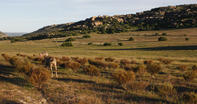
In response to the phenomenal demand for rooibos tea, the footprint of commercial rooibos has expanded considerably. And bizarrely, it looks as though this might, for the moment, be helped in part by the shifting climatic envelope, allowing the southern range to thrive while the north remains productive for the moment.
Johan Brand, technical manager at Rooibos Limited, said the crop has thrived in Piketberg during the past few seasons when normal rainfall for the area would ordinarily drown plantations. This is allowing more farming of the plant in formerly higher rainfall areas in the southern reaches of the fynbos biome.
Signs of Strain
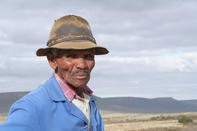
Four decades of climbing temperatures are leaving a mark on traditional rooibos farming areas. Rhoda Malgas, with the Nieuwoudtville-based NGO, Indigo Development and Change, says that many commercial plantations are showing signs of strain, as their longevity is dropping from the normal seven to 12-year lifespan of an ordinary commercial plant, to as little as five.
Rising temperatures, increased drought and altered rainfall patterns which climate change models predict will occur in the two most vulnerable provinces, the Western and Northern Cape will continue pushing certain commercial rooibos plantations to the very margins of viable production.
And this in a province that is expected to see a further 1.5°C increase along the coast and a 3°C increase in the interior by 2050. Winter rainfall will decrease with a slight increase in late summer downpours and higher precipitation in the Cape Fold Mountains, although the overall trend is one of drying. The province will experience more warm days and fewer cooler days.
Poor Man’s Tea
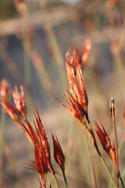
Wild rooibos was once known as the poor man’s tea in much the same way that oysters were collected from the sea by peasants long before it became the food of the elite. Over the years, wild rooibos was used as a substitute for families when there was no money to buy the more “classy” English tea.
Or English tea was blended into the wild rooibos to elevate its proletarian status. Many rural families, still take their children with them into the veld to collect wild tea and teach them how to process it. It is picked by hand, chop up into fine twigs often using a small axe, before being “bruised” using the back of the axe.
The twiggy, olive-green stuff is left to sweat for 24 hours before being spread out on a flat rock to dry in the sun, a process that turns it to that typical rich brown-red colour we’ve come to associate with the tea. Commercial rooibos goes through the same process, only on an industrial scale.
By Leonie Joubert